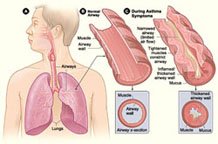What is Asthma?
Asthma is a serious, sometimes life-threatening chronic respiratory disease that affects the quality of life for 25 million Americans, including more than 4 million children. Although there is no cure for asthma yet, asthma can be controlled through medical treatment and management of environmental triggers. EPA is committed to educating all Americans about asthma so that everyone knows what asthma is, how the environment can affect asthma patients, and how to manage environmental asthma triggers.
On this page:
- Who is at Risk for Asthma?
- Asthma Triggers
- EPA’s Community-Based Asthma Program Outreach
- Additional Resources
Who is at Risk for Asthma?
Anyone can get asthma - people of all ethnic groups, men and women, the young and elderly, city dwellers and rural dwellers. In the United States, 25 million people have asthma. Asthma is common among children and teens, and about 3 students in an average classroom of 30 have asthma.
While no one knows for sure why some people develop asthma and others don't, we do know that it is a combination of your family history and your environment.
There is no cure for asthma. Once you have asthma, you will have the disease for the rest of your life. But with proper care, you can lead a healthy, productive, fully active life.
To learn more about managing asthma visit Asthma Triggers: Gain Control or Noattacks.org.
Asthma Triggers
Several factors found in both indoor and outdoor environments that can cause, trigger, or exacerbate asthma symptoms. You might be surprised by the list of common environmental asthma triggers, and how simple it can be to reduce their impact and eliminate them from your environment.
Preventing Asthma Attacks
Step 1 - Talk to a Doctor
If you think that you or your child may have asthma, talk to a doctor. Your doctor will work with you to diagnose asthma and keep you or your child from having asthma attacks by helping you with the following:
- Learning what triggers asthma attacks;
- Identifying asthma triggers in your home;
- Talking about ways to get rid of triggers in your home; and
- Finding out what medicine(s) to take.
Step 2 - Make a Plan
Ask your doctor to help you create an asthma action plan to prevent asthma attacks. An asthma action plan will help you control asthma on a regular basis. Use this plan together with your doctor to write down ways to manage asthma, both on a routine daily basis and during an attack. Look on the back for a list of possible asthma triggers and ways to avoid them.
Download a copy of the asthma action plan.
- English (PDF)(2 pp, 138 K)
- Spanish (Plan de acción contra el asma) (PDF)(3 pp, 74 K)
- Chinese (哮喘行動計劃) (PDF)(8 pp, 11 MB)
- Vietnamese (Kế hoạch hành động hen suyễn) (PDF)(8 pp, 10 MB)
Step 3 - Asthma-Proof Your Home
Triggers are a part of everyday life. Asthma attacks can be triggered by things like mold growing on your shower curtain or tiny dust mites that live in blankets, pillows, or your child's stuffed animals. Learn more about things that might trigger an asthma attack and what you can do to get rid of them and to stay healthy.
EPA’s Community-Based Asthma Program Outreach
The Asthma Community Network supports community-based asthma initiatives to improve asthma health outcomes and help transfer knowledge across community programs. Join the Asthma Community Network today!
Additional Resources
- AirNow.gov - EPA's website monitors outdoor air quality and informs the public of health risks from outdoor air pollution.
- NoAttacks.org - The Partner website provides information to help children with asthma and their families manage environmental asthma triggers in and around their homes. Informacion disponible en espanol.
- IAQ Tools for Schools - This guidance offers tools and resources to empower school communities to protect children from environmental asthma triggers.
- Clean Air Research - This website offers information on how we conduct and coordinate research to increase scientific knowledge about asthma and ways to manage environmental factors that cause asthma and trigger asthma attacks.
- Implementing An Asthma Home Visit Program: 10 Steps to Help Health Plans Get Started (PDF)- This publication provides health care providers and healthcare plan administrators with information, education and resources to incorporate environmental management into clinical practices and standards of care for asthma patients.

